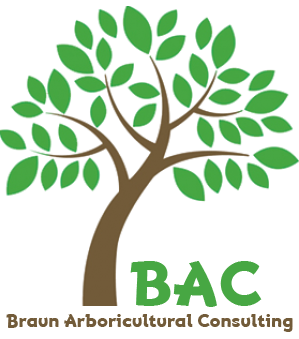Things You Should Know about Trees
Their worth, their uses, how to monitor and care for them.
How much is your tree worth?
In the case of a large tree, your tree is worth considerably more than the nursery stock planted long ago. Well maintained and placed trees as well as shrubs and other plants add considerable value to both residential and commercial properties, but the worth is ultimately dependent on site specific factors.
Plant appraisal is a process of assigning an estimate of value to plants based on there size, species, condition, contribution to aesthetic and functional value, placement on the site, and neighborhood property values. The estimated value aids decisions about retaining vegetation and settlements after a casualty.
Appraisals are performed at the site, taking all relevant factors into account. The result of the appraisal is a written report that is legally recognized. Braun Arbroricultural utilizes techniques recommended by the American Society of Consulting Arborists (ASCA), and, according to their Standards of Professional Practice, appraisals are done in an unbiased manner based on hourly costs and not a contingency fee.
What do my trees do for me?
Trees provide a range of both functional services and aesthetic values:
- Moderation of the local environment (temperature, wind, shade, etc),
- Screening from undesirable views,
- Framing of desirable views,
- Providing texture, color, and fragrance
- Botanical interest.
Selection of the proper tree or other vegetation is critical, so that the plant has room to reach maturity and enhances a safe and pleasing environment.
Plants can negatively affect property value as well. For example, planting trees that are very large at maturity under overhead wires and adjacent to homes often incur large costs in the future for pruning or removal.
In addition, planting highly flammable trees or shrubs as foundation plantings or along driveways may contribute to highly damaging wildfire.
How do I maintain tree health and safety?
First of all, in planting new trees, trees should be matched to the site. This includes picking species (and cultivars) that will fit into and enhance the property, while also being appropriate for the local soil and climate.
While species can be planted out of their climate zone, special care may be needed, and the tree may die or be damaged in a harsh year.
Using the proper planting technique, applying the correct after care, and avoiding injury to the young tree all contribute to the development of a mature tree that is healthy and stable.
Monitoring for disease or insect pests, and developing a pleasing and safe form, may take occasional visits by professional arborists but can also be done in large part by knowledgeable property owners.
Major pruning, removal, or risk assessments should be left to qualified professionals to avoid loss or damage, including personal injury.
Similarly, existing large old trees should be professionally assessed for risk and health; many conditions are subtle that can prove hazardous to people and property, or injurious to the tree but can be corrected if diagnosed and mitigated in time.
Trees naturally shed large limbs, whether live or dead, lose large sub-trunks that are weakly attached, may suffer significant damage from insects if they reach high levels, and may have significant internal decay with little outward sign. All these factors can be ignored (and often are), but tree mortality or breakage typically can also be traced back to these factors and so is preventable if intervention is done in a timely fashion.
Property owners may also inadvertently damage their trees from over or under watering, hitting them with mowers and weed-eaters, hammocks and support wires, overuse of fertilizers, and drift or misuse of herbicides.
Learning about your trees requirements and symptoms of decline can make a major difference in maintaining health.
Braun Arboricultural Consulting (541) 806-0347
